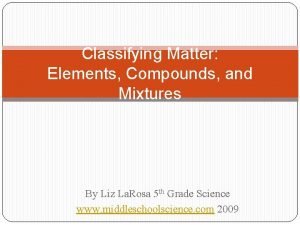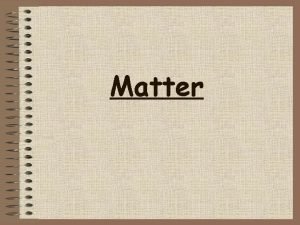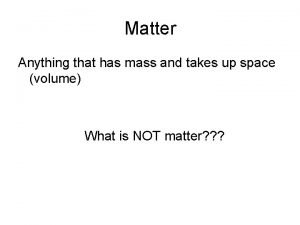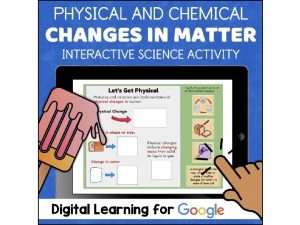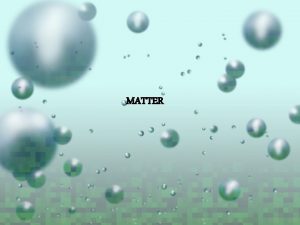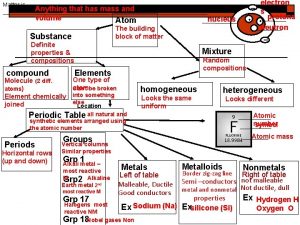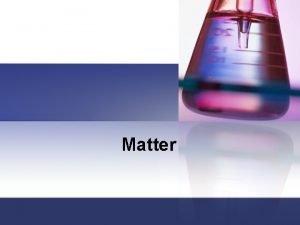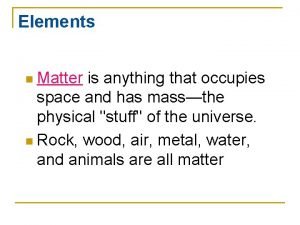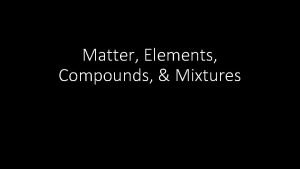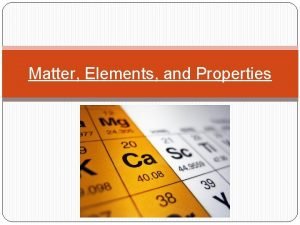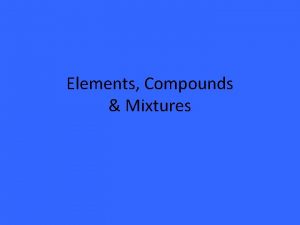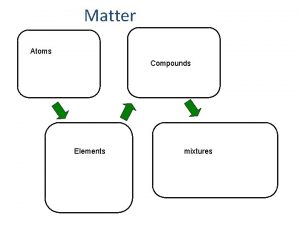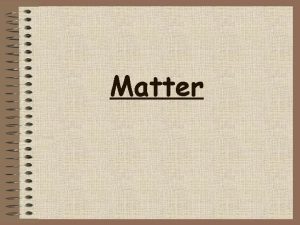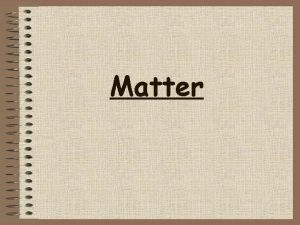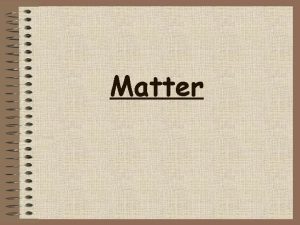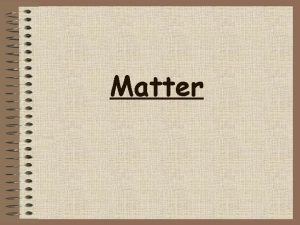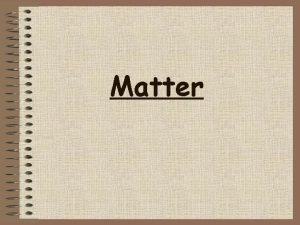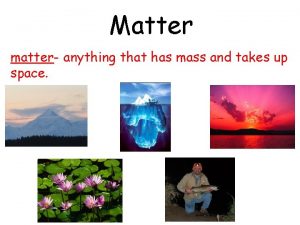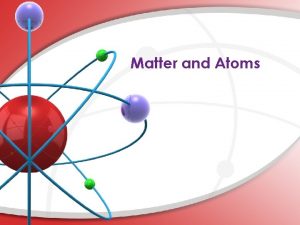Compounds And Elements Matter l anything that takes
















- Slides: 16

Compounds And Elements

¡ Matter: l anything that takes up space & has a mass Ex. l a desk pizza silver necklace oxygen

Classification: Everything in the world that has a mass is called “matter” ¡ Matter can be classified as: ¡ Matter Pure Substance Element Ex. gold Compound Ex. water Mixture Heterogeneous Mixture Homogeneous Mixture

¡ Pure Substance: composed of a single substance with the same properties throughout l Ex. water l Ex. table salt l ¡ Mixture: combinations of two or more substances that are not chemically combined (mixed) l Easily separated l Ex. fruit salad l Ex. sugar in coffee l

A pure substance can be further broken down into an element or a compound…… Elements: ¡ ¡ ¡ simplest form of matter cannot be separated or broken down into simpler substance Ex. Ex. Oxygen Aluminum Gold Copper

Recall, a pure substance can be further broken down into an element or a compound Compounds: ¡ ¡ ¡ substance made of two or more elements can be separated into simpler substance Ex. Ex. Water (H 2 O) Carbon dioxide (CO 2) Sugar (C 6 H 12 O 6) Salt (Na. Cl)

¡ NOTE: With chemical reactions you can go from an element to compound & vise versa!!! Element Compound Ex. oxygen & hydrogen Ex. water (H 2 O) O H H H O H

State whether the following are examples of an element or a compound. A gold ring element Rust (Fe 2 O 3) compound Carbon monoxide (CO) Aluminum Foil Calcium compound element

State whether the following are examples of an element or a compound or a mixture A blueberry muffin mixture Chunky Soup mixture Salt (Na. Cl) compound element compound Helium Water (H 2 O)

State whether the following pictures represent an element or a compound or a mixture Element Compound Mixture Compound

Which statement best describes a compound. A) A pure substance that has a high melting point. B) A mixture that is formed by two or more elements. C) A pure substance that is formed by two or more elements.

The Molecule Individual atoms can combine to form molecules. ¡ A molecule is a group of two or more chemically bonded atoms. ¡ A molecule is the smallest unit of a compound. ¡ Eg: H 2 O, CO 2, C 6 H 12 O 6

Molecules: ¡ ¡ ¡ Recall elements can combine to form compounds But when atoms combine, they do so in specific ratios For example: l l Water, H 2 O Combines 2 Hydrogens for every 1 Oxygen

Molecules: ¡ ¡ An atom wants to be stable To be stable, an atom must have a full outer electron shell (8 electrons) This is called the Octet Rule ¡ Atoms combine together, forming bonds, to fill their outer electron shell

Atoms combine to obtain a complete outer electron shell (8 valence electrons) ¡ Metals tend to lose electrons to achieve this and non-metals tend to gain electrons ¡

Group Number IA IIIA IVA VA VIIA VIIIA Example Li Be B C N O F Ne Valence electrons 1 2 3 4 5 6 7 8 Tendency Lose 1 e- Lose 2 e - Lose 3 e - Gain or lose 4 e- Gain 3 e - Gain 2 e - Gain 1 e - None (stable)
 Anything that has mass and takes up space
Anything that has mass and takes up space Anything that has matter and takes up space
Anything that has matter and takes up space Matter anything that
Matter anything that Defintion of matter
Defintion of matter Types of matter elements compounds and mixtures
Types of matter elements compounds and mixtures Mass vs matter
Mass vs matter Anything that has mass and take up space
Anything that has mass and take up space 7 diatomic elements
7 diatomic elements Matter is anything that
Matter is anything that Anything that has volume or mass is
Anything that has volume or mass is Whats the basic unit for volume
Whats the basic unit for volume Anything that takes up space and has mass
Anything that takes up space and has mass Ionic metallic and covalent bonds venn diagram
Ionic metallic and covalent bonds venn diagram Anything that has mass and volume
Anything that has mass and volume Matter is anything that has mass and occupies space
Matter is anything that has mass and occupies space Matter is anything that occupies space and has
Matter is anything that occupies space and has Phân độ lown
Phân độ lown




